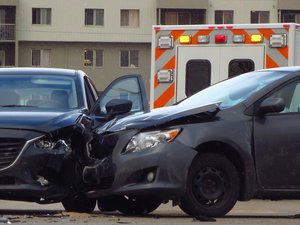
Personal injury is a generic title that covers a lot of ground. Basically, a personal injury claim arises when someone is injured or killed as a result of someone else’s negligence (carelessness). Let’s break this down into three distinct components.
Negligence
First, there must be negligence by the other party. Negligence means failing to do what a reasonably prudent person would have done under the same or similar circumstances. Let me give you an example:
You are driving down the street and approach an intersection. The light is green, and you proceed through the intersection. Unfortunately, another person driving on the intersecting street is texting on their cell phone and does not see they have a red light. Without warning, the car plows into the side of your car and you are seriously injured. Was the other driver negligent? Yes. They ran a red light and did not see the red light because they were texting on their cell phone. They failed to keep a proper lookout while operating a motor vehicle. While it is common to see people texting on the cell phone while driving, most people would agree it is not what a reasonably prudent person would do under the same or similar circumstances. Their attention should have been on the road and traffic in front of them. You have a right to bring a lawsuit against this other driver for the injuries you sustained because the other driver was negligent and caused your injuries.
Product Defect
A subset of negligence is a concept called strict products liability. If a product causes an injury to the person and the product was defective, a person can bring a negligence claim against the manufacturer of the product in addition to a strict liability claim. Under strict liability, Texas requires that you show that the product was “unreasonably dangerous” at the time it entered the stream of commerce (originally shipped or sold). The “unreasonably dangerous” aspect requires that a defect be present. Generally, there are three types of defects—design, marketing, and manufacturing. A design defect means something was defective in the design of the product. A marketing defect is one in which there were no warnings about the danger that caused the injury, or the warnings were inadequate. A manufacturing defect is one where the product was manufactured incorrectly. It may have been designed correctly, but something went wrong in the manufacturing process.
Causation
The second component is proximate cause. Proximate cause involves two aspects. First, you must prove that the negligent act in fact caused the injury. This is sometimes referred to “but-for” causation. But for the negligent act, the person would not have been injured. Second, you must prove that the injury was a direct, foreseeable, natural consequence of the negligent act. Take the previous example of the car accident. The actions of the inattentive driver who ran the red light were the proximate cause of the injuries sustained by you. By running the red light and being inattentive (negligent), the driver’s car struck your car that had a green light. But for the actions of the negligent driver, you would not have been injured. And it was definitely foreseeable that if the driver did not keep a proper lookout while driving, someone could be injured. However, the causation component can also be the hardest part to prove. Here’s an example:
You are involved in an accident and injure your back. However, six months before this accident, you had a back injury you felt had healed. The person you sue is going to argue that your back injury was not caused by the accident but was a pre-existing condition. This is where medical experts come into play. You will probably need a doctor to testify that your previous back injury had healed and this back injury was caused by the accident. Or you will need the doctor to testify that your back injury following the car wreck was an aggravation of a pre-existing condition. Either one is entitled to compensation in Texas.
